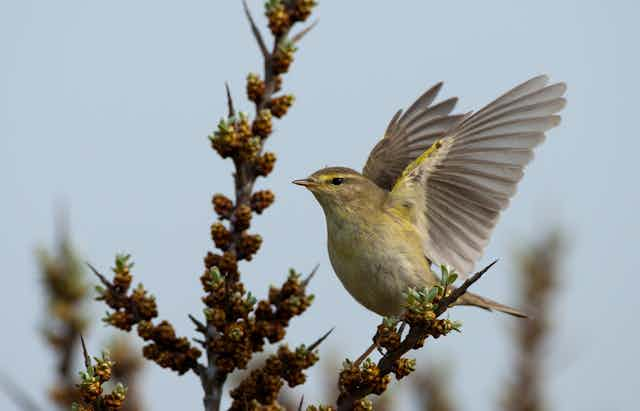If you hear a bird singing in the spring, you might assume it’s calling to a potential mate in the hope of producing offspring. But in parts of the UK, birdsong could be helping to mask the fact that the populations of certain species are in sharp decline. Our research into willow warblers has found that, in a growing number of locations, many males are failing to attract a mate – with significant consequences for the species.
Using data from surveys of willow warbler populations across the UK, we found that the male-to-female ratio has changed from about 50:50 in 1994 to about 60:40 in 2012. But we also found this male bias was greater in small populations of birds, which are particularly common in the agriculture-dominated regions of south-east Britain. This suggests that the fragmented patches of remaining habitat in these areas can attract male but not female warblers. This skews the national populations and shrinks these small populations further because not enough females means fewer offspring.
The fact that male birds sing makes them much easier to count than females, so when scientists want to measure wild bird populations they usually count the singing males and use that to estimate the total. However, this doesn’t give us a clear picture of the ratio between males and females in a specific location, especially as unpaired males often sing for longer than paired males during the breeding season.
Capturing birds in mist nets (very fine nylon nets that are virtually invisible) can give more accurate estimates of numbers of males and females. Across the UK, citizen scientists catch, ring and recapture birds as part of the British Trust for Ornithology Constant Effort Sites Scheme.

Capturing and recapturing ringed males and females allows us to calculate sex ratios and survival rates. To do this, we have to take into account the fact that we’re more likely to capture males during the breeding season because of the way they move around and spend less time at the nest than females.
Together with our colleagues Rob Robinson and Jacquie Clark, we studied this British Trust for Ornithology data about captured and recaptured willow warblers to produce a more accurate picture of sex ratios. We found that male-bias is more common in areas with small populations, which are now widespread across much of southern and eastern England.
Females choosing better locations
This could be because females have lower annual survival rates than males. But the difference between these survival rates wasn’t consistently greater in the male-dominated populations. And survival rates of males and females have not changed over the period in which male bias has become more common.
If females are less common in small populations, despite being no more likely to die, this suggests that they must be less likely to join these small populations. Most breeding birds return to the same breeding sites each year, and males often breed close to the area in which they were hatched. But females are more likely to disperse and select a breeding location elsewhere. Our findings suggest that females are more likely to choose busier breeding locations where the abundance of willow warblers is higher and the habitat is likely to be of a better quality.
If females are more attracted to sites where there are more willow warblers in the first place, then to tackle the declining national population we should focus on creating and maintaining habitats that can support large numbers of birds. While small patches of habitat might be enough for a male to set up a territory, females looking for a mate find these conditions less attractive. And they may simply be less likely to encounter sparsely distributed lone males.

